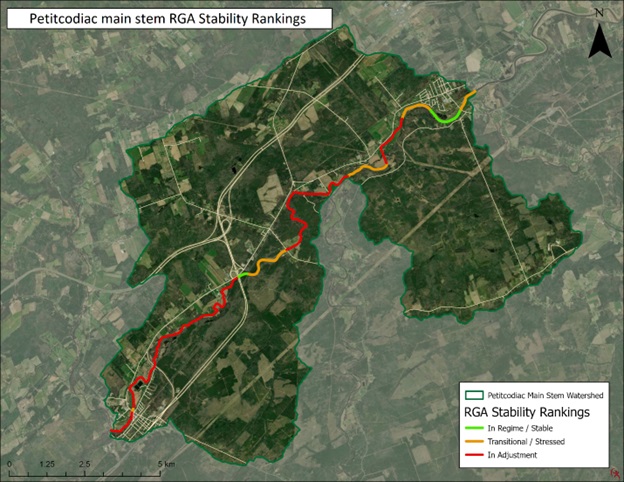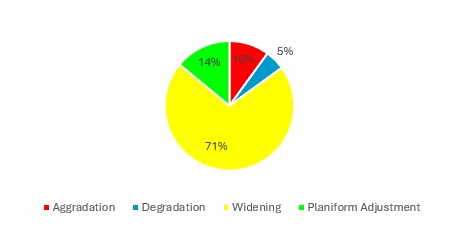Third Level Assessment – Aquatic and Riparian Habitat Assessment
Geomorphic Assessments
Data collected from the Rapid Geomorphic Assessment (RGA) was used to evaluate the geomorphic condition and stability of the assessed reaches of the main stem of the Petitcodiac River. In order to interpret the geomorphic data, the included maps of the watercourse are highlighted according to reach stability as well as the Primary Geomorphic Processes impacting each reach.
Rapid Geomorphic Assessments are used to quantify channel stability based on the presence and (or) absence of key indicators of channel adjustment with respect to four categories: 1) Aggradation, 2) Degradation, 3) Channel Widening, and 4) Planimetric Form Adjustment. Each indicator is described in detail below.
Aggradation
Channel aggradation may occur when the sediment load to a river increases (due to natural processes or human activities), and it lacks the capacity to carry it. Piles of sediment in the river can re-direct flows against the banks, leading to erosion and channel widening.
Typical indicators used to identify aggradation include:
- Shallow pool depths.
- Abundant sediment deposition on point bars.
- Extensive sediment deposition around obstructions, channel constrictions, at upstream ends of tight meander bends, and in the overbank zone.
- Most of the channel bed is exposed during typical low flow periods.
- High frequency of debris jams.
- Coarse gravels, cobbles, and boulders may be embedded with sand/silt and fine gravel.
- Soft, unconsolidated bed.
- Mid-channel and lateral bars.
Degradation
Degradation occurs as the river cuts deeper into the land and decreases its gradient. This can occur from a rapid removal of streambed material due to an increase in discharge, water velocity, or a decrease in sediment supply. Bed lowering can move in both an upstream (as a headcut or nick point) and/or downstream direction. Indicators of degradation include:
- Elevated tree roots.
- Bank height increases as you move downstream.
- Absence of depositional features such as bars.
- Head cutting of the channel bed.
- Cut face on bar forms.
- Channel worn into undisturbed overburden/bedrock.
Widening
Widening typically follows or occurs in conjunction with aggradation or degradation. With aggradation, banks collapse when flows are forced on the outside, and the river starts to widen. Wide, shallow watercourses have a lower capacity to transport sediment and flows continue to concentrate towards the banks. Widening can be seen with degradation, as it occurs with an increase in flows or decrease in sediment supply. Widening occurs because the stream bottom materials become more resistant to erosion (harder to move) by flowing waters than the stream banks.
Indicators of widening include:
- Active undermining of bank vegetation on both sides of the channel, and many unstable bank overhangs that have little vegetation holding soils together.
- Erosion on both right and left banks in riffle sections.
- Recently exposed tree roots.
- Fracture lines at the top of banks that appear as cracks parallel to the river, which is evidence of landslides and mass failures.
- Deposition on mid-channel bars and shoals.
- Urbanization and storm water outfalls leading to higher rate and duration of runoff and channel enlargement typically in small watersheds with >10% impervious surface.
Planform Adjustment
These are the changes that can be seen from the air when looking down at the river. The river’s pattern has changed. This can happen because of channel management activities (such as straightening the bends of the river with heavy equipment). Planform changes also occur during floods. When there is no streambank vegetation with roots to hold soil in place, rivers cut new channels in the weak part of the bank during high water. Planform adjustments typically are responses to aggradation, degradation, or widening geomorphic phases. Indicators include:
- Flood chutes, which are longitudinal depressions where the stream has straightened and cut a more direct route usually across the inside of a meander bend.
- Channel avulsions, where the stream has suddenly abandoned a previous channel.
- Change or loss in bed form, sometimes resulting in a mix of plane bed and pool-riffle forms.
- Island formation and/or multiple channels.
- Additional large deposition and scour features in the channel length typically occupied by a single riffle/pool sequence (may result from the lateral extension of meanders).
- Thalweg not lined up with planform. In meandering streams, the thalweg typically travels from the outside of a meander bend to the outside of the next meander bend.
- During planform adjustments, the thalweg may not line up with this pattern.
Upon completion of the field inspection, indicators are tallied for each category to produce an overall reach stability index. The index classified the channel in one of three stability classes:

The RGA stability index results for the main stem of the Petitcodiac River are shown in Figure 19. Approximately 66 % of the reaches are in adjustment – as per Table 4- the most sensitive state. Only 10 % of the reaches assessed were found to be stable (in regime). The remaining 24 % were transitional between these two states.



Primary Geomorphic Processes
The primary geomorphic process identified on the main stem of the Petitcodiac River are shown in Figure 21. Widening was the most common process observed at 71%, followed by Planiform adjustment 14%, Aggradation 10%, and Degradation 5%.


This RGA data indicates that most of the riverbanks along the main stem of the Petitcodiac River are experiencing some degree of stress and disturbance, with the primary form of this being widening of the channel. The degree of this disturbance is greater the higher one goes in the system, which might initially appear to be different from what is often seen for RGA results within other watersheds in this series of Stewardship plans. However an important distinction between the main stem of the Petitcodiac and the other watersheds examined is that the top of the mainstem is not its headwaters.
Unlike the upper reaches of the various Petitcodiac tributaries (above which by definition there is just a ridge beyond which lies a different watershed), the top of the main stem is simply the somewhat arbitrary point along the river channel where, the North River and the Anagance (actual headwaters) have come together. Here the main river channel stops, being called the North River and is recognized by the government as the Petitcodiac River. As such, unlike in other watershed units, the causes of disturbance on the main stem are not limited to activities taking place within the area examined, but also include those from outside of the area, further upstream. For example the upper main stem of the Petitcodiac is impacted by forestry activity on the Anagance River, and agriculture on the North River. Disturbance within the main stem is widespread. The purpose of RGAs is to identify and prioritize areas needing the most attention- however with so much of the main stem “in adjustment” other factors – such as landowners, and significance to wildlife take on even greater importance in determining which projects to undertake.












